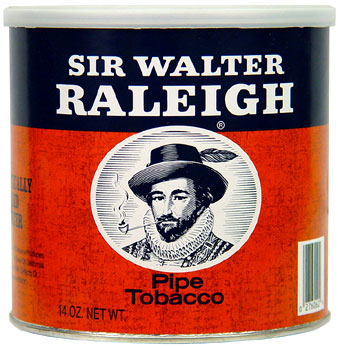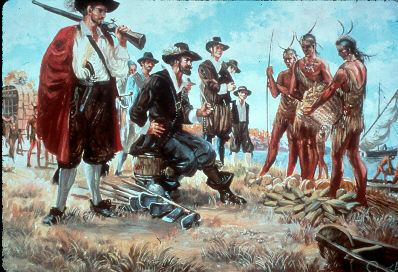
The Virginia Company of London
From the National Park Service: Historic Jamestowne -- In the late 1580s, Sir Walter Raleigh attempted to plant a colony for England in present-day North Carolina. This unsuccessful and expensive settlement, often referred to as The Lost Colony, made the English crown wary of trying again.
It was not until 1606 that the Virginia Company of London received a charter from the newly-crowned King James I. Following the precedent set by other companies such as the Moscovy Company and East India Company, the Virginia Company was a joint-stock company, which sold shares. All who purchased shares at a cost of £12 10s shared in the success or failure of the venture. The Virginia Company was formed both to bring profit to its shareholders and to establish an English colony in the New World. The Company, under the direction of its treasurer Sir Thomas Smith, was instructed to colonize land between the 34th and 41st northern parallel.

In December 1606, the Virginia Company's three ships, containing 144 men and boys, set sail. On May 13, 1607, these first settlers selected the site of Jamestown Island as the place to build their fort.
In addition to survival, the early colonists had another pressing mission: to make a profit for the stockholders of the Virginia Company. Although the settlers were disappointed that gold did not wash up on the beach and gems did not grow in the trees, they realized there was great potential for wealth of other kinds in their new home. Early industries such as glass manufacture, pitch and tar production and beer and wine making took advantage of natural resources and the land's fertility. However, the settlers could not devote as much time as the Virginia Company would have liked to their financial responsibilities. They were too busy trying to survive.

Within the three-sided fort erected on the banks of the James, the settlers quickly discovered that they were, first and foremost, employees of the Virginia Company of London, following instructions of the men appointed by the Company to rule them. In exchange, the laborers were armed and received clothes and food from the common store. After seven years, they were to receive land of their own. The gentlemen, who provided their own armor and weapons, were to be paid in land, dividends or additional shares of stock.
Initially, the colonists were governed by a president and seven-member council selected by the King. Leadership problems quickly erupted and Jamestown's first two leaders coped with varying degrees of success with sickness, Indian assaults, poor food and water supplies and class strife.
When Captain John Smith became Virginia's third president, he proved the strong leader that the colony needed. Industry flourished and relations with Chief Powhatan's people improved. In 1609, the Virginia Company received its Second Charter, which allowed the Company to choose its new governor from amongst its shareholders. Investment boomed as the Company launched an intensive recruitment campaign. Over 600 colonists set sail for Virginia between March 1608 and March 1609.

Unfortunately for these new settlers, Sir Thomas Gates, Virginia's deputy governor, bound for the colony, was shipwrecked in Bermuda and did not assume his new post until 1610. When he arrived, he found only a fraction of the colonists had survived the infamous "Starving Time" of 1609-1610. All too soon, the Mother Country learned of Virginia's woeful state. The result was predictable: financial catastrophe for the Company. Many new subscribers reneged payment on their shares, and the Company became entangled in dozens of court cases. On top of these losses, the Company was forced to incur further debt when it sent hundreds more colonists to Virginia.
There was little to counter this crushing debt. No gold had been found in Virginia; trading commodities produced by exploitation of the raw materials found in the New World were minimal. Attempts at producing glass, pitch, tar and potash had been barely profitable and, regrettably, such commodities could be had far more cheaply on the other side of the Atlantic.
Increasingly bad publicity, political infighting and financial woes led the Virginia Company to organize a massive advertising campaign. The Company plastered street corners with tempting broadsheets, published persuasive articles, and even convinced the clergy to preach of the virtues of supporting colonization. Before the Company was dissolved, it would publish 27 books and pamphlets promoting the Virginia venture.

To make shares more marketable, the Virginia Company changed its sales pitch. Instead of promising instant returns and vast profits for investors, the Company exploited patriotic sentiment and national pride. A stockholder was assured that his purchase of shares would help build the might of England, to make her the superpower she deserved to be. The heathen natives would be converted to the proper form of Christianity, the Church of England. People out of work could find employment in the New World. The standard of living would increase across the nation. How could any good, patriotic Englander resist?
The English rose to the bait. The gentry wished to win favor by proving its loyalty to the crown. The growing middle class also saw stock purchasing as a way to better itself. But the news was not all good. Although the population of Jamestown rose, high settler mortality kept profits unstable. By 1612, the Company's debts had soared to over £1000.
A third charter provided a short-term resolution to the Virginia Company's problems. The Company was permitted to run a lottery as a fundraising venture. Other attractive features of the charter allowed Virginia's assembly to act as the colony's legislature and also added 300 leagues of ocean to the colony's holdings, which would include Bermuda as part of Virginia. But the colony was still on shaky ground until John Rolfe's successful experiment with tobacco as a cash crop provided a way to recoup financially.
Unfortunately by 1616, the Virginia Company suffered further adversity. The original settlers were owed their land and stock shares; initial investors at home were owed their dividends. The Company was forced to renege on its cash promises, instead distributing 50-acre lots in payment. The next year, the Company instituted the headright system, a way to bring more settlers to Virginia. Investors and residents were able to acquire land in paying the passage of new settlers. In most cases, these newcomers spent a period of time in servitude on the investor's land. Sir Edwin Sandys, a leading force in the Virginia Company, strongly supported the headright system, for his goal was a permanent colony which would enlarge British territory, relieve the nation's overpopulation, and expand the market for English goods. Sir Thomas Smith, as the Company's Treasurer, had a different dream: the Virginia Company's mission was to trade and to make a profit.

Four states in the USA that are "Commonwealths: Virginia, Kentucky, Pennsylvania and Massachusetts
In the end, it was Sandys' vision which prevailed. When he became Treasurer of the Company in 1619, he moved forward to populate the colony and earn a protective status for the tobacco crop which had become the cash crop of Virginia. At the same time, he urged colonists to diversify their plantings and thus become less reliant on only one staple. The colonists ignored this advice, to their later dismay.
In 1621, the Company was in trouble; unpaid dividends and increased use of lotteries had made future investors wary. The Company debt was now over £9000. Worried Virginians were hardly reassured by the advice of pragmatic Treasurer Sandys, who warned that the Company "cannot wish you to rely on anything but yourselves." March 1622, the Company's and the colony's situation went from dire to disastrous when the Powhatan Indians staged an uprising which wiped out a quarter of the European population of Virginia. When a fourth charter, severely reducing the Company's ability to make decisions in the governing of Virginia, was proposed by the Crown, subscribers rejected it. King James I forthwith changed the status of Virginia in 1624. Virginia was now a royal colony to be administered by a governor appointed by the King. The Virginia Assembly finally received royal approval in 1627 and this form of government, with governor and assembly, would oversee the colony of Virginia until 1776, excepting only the years of the English Commonwealth.

The Virginia Company of London, so far as achieving its aims as a profitable stockholding company, was a dismal failure. Despite numerous creative and desperate attempts to make Virginia stable and financially successful, the investors never achieved a profit, while the colonists suffered from the factionalism and mismanagement by the administration on the other side of the Atlantic.
But other motives for establishing for establishing Virginia were achieved. England's territory was increased vastly and the new land could be settled and its natural resources harvested. Spanish colonial enterprise in the New World was challenged. England's laws, language and religion were transplanted to a new place, laying the foundations for what would become the United States of America. (source; National Parks Service)


No comments:
Post a Comment